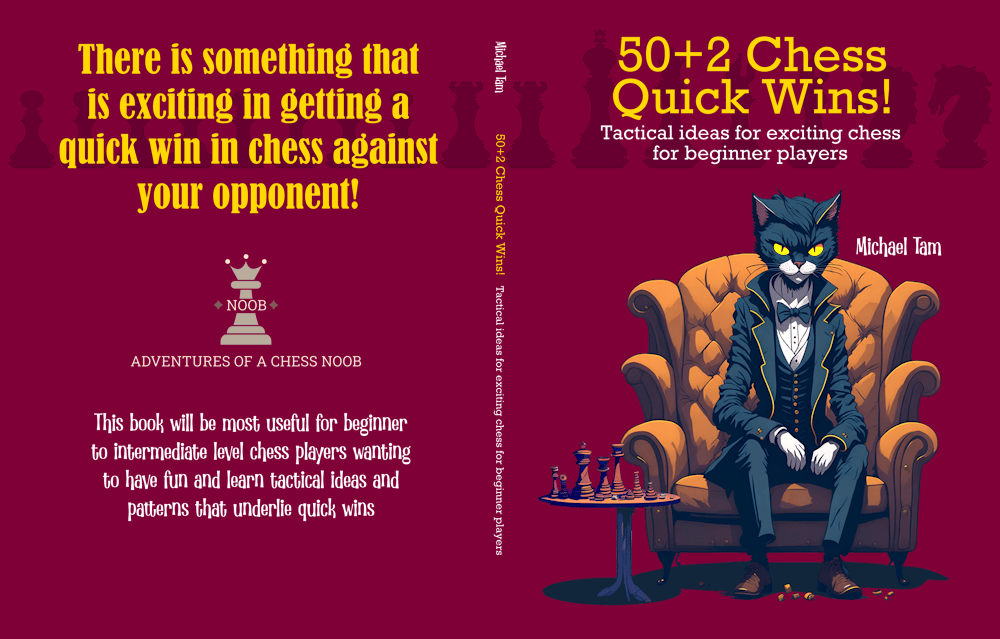
Fool's Mate in a REAL GAME! 🤪 OMG!! ⚡ Quick Wins #86
#nimzolarsen #quickwins #foolsmate
chess noob Quick Wins! is a series of short videos, to demonstrate very quick wins! As a beginner, you become aware of the Scholar's Mate and the Fool's Mate, but neither of these show up in real games. However, there are tricky quick checkmates and wins that occur, even at the intermediate level of chess.
Today's game was sent in by one of my Australian subscribers @atravisb who got this beautiful 6-move win. And contrary to my opening statement about quick wins, this one, incredibly, actually features a Fool's Mate structure! 🤯 Let's go!
Now, you might ask, how exactly was this possible? Well, my subscriber with the white pieces led with an uncommon hypermodern opening (1. b3), the Nimzowitsch-Larsen Attack! And perhaps of no surprise to the hypermodern enthusiasts, this opening is completely sound with Stockfish giving it an evaluation of [0.00]!
![]()
A historical note:
The very first game in the LumbrasGigabase of (1. b3) was played by Maarten van 't Kruijs (1813-1885), a Dutch chess master who dominated chess in the Netherlands in the 19th century and was probably one of the strongest players in the world during the period. He is perhaps best remembered nowadays for his eponymous opening, the van 't Kruijs Opening (1. e3). van 't Kruijs was a private man, and few details remain from history. Check out (van 't Kruijs — De Heer, 1851, Amsterdam) where van’ t Kruijs plays a slow, creeping, and relentless forward advance in the opening and early middlegame, and then sweeps into a crushing advantage after De Heer incorrectly lashes out on move 22!
What about the namesakes of the opening?
Aron Nimzowitsch (1886-1935) was a Latvian-born Danish chess master, probably one of the top 3 players at his peak between 1927-1931, and one of the leaders of hypermodernism and most influential chess theorists of all time. He played (1. b3) at the height of his strength in the late-1920s. GM Jørgen Bent Larsen (1935-2010) was another Danish master who was known for playing unusual openings, including using (1. b3) regularly in elite competition. I’ve included all games of the Nimzowitsch-Larsen Attack played by Nimzowitsch and Larsen in the following PGN for you to explore and peruse!

![]()
In this game Black responded with (1… b6), the Symmetrical Variation. Interesting! 🤔 Symmetrical moves by Black are usually “fine” in most openings, but Black cannot persist with this approach. Usually within a few moves, White’s first mover advantage will take hold in all sensible lines.
White fianchettoes their bishop, and then develops their king’s knight, trying to influence the centre with pieces from a distance rather than occupying it directly with pawns. And on move 3, Black makes their first inaccuracy and tactical mistake with (3… f6?!). There is a certain logic to this move; having a diagonal attacking piece (e.g., a pawn or a bishop) placed two intervening squares away from a knight restricts its forward movement. However, as per GM Ben Finegold, “never play f6!” in the opening!
White noticed the f-pawn’s movement and the resulting weakening of the light square diagonal to Black’s king and play a sneaky, tricky move with (4. e3!?). This covertly opens the diagonal for a potential Qh5+, though their f3-knight is still in place. This potentially works as hypermodern openings operate on some different principles, and for beginners, it can cloud the intuitions that come when playing a classical opening. And a “quick wins” psychological insight: if Black forgot about the risk from an early f-pawn move, they are likely to have a relatively blindness to an attack down that diagonal!
And we see this immediately with (4… g5??) as Black doubles-down with their flank strategy, probably with the intention of playing g4 to harass White’s knight to win tempo. This is a blunder as Black has now critically weakened that light square diagonal! Indeed, it’s the Fool’s Mate pattern!
White captures the g5-pawn with their knight (5. Nxg5!) and too late, Black probably realises their mistake… or did they? Black probably thought that their error was in not recognising that their f6-pawn was pinned to their g8-rook by White’s fianchetto bishop, and thus, not actually defending the g5 square. And thus, they missed the real attack. Black makes a final blunder by fianchettoing their second bishop, missing the impending mating. White strikes with (6. Qh5+) and Black resigns, as (6… Kf8 Qf7#) is a forced inevitability. GG!




